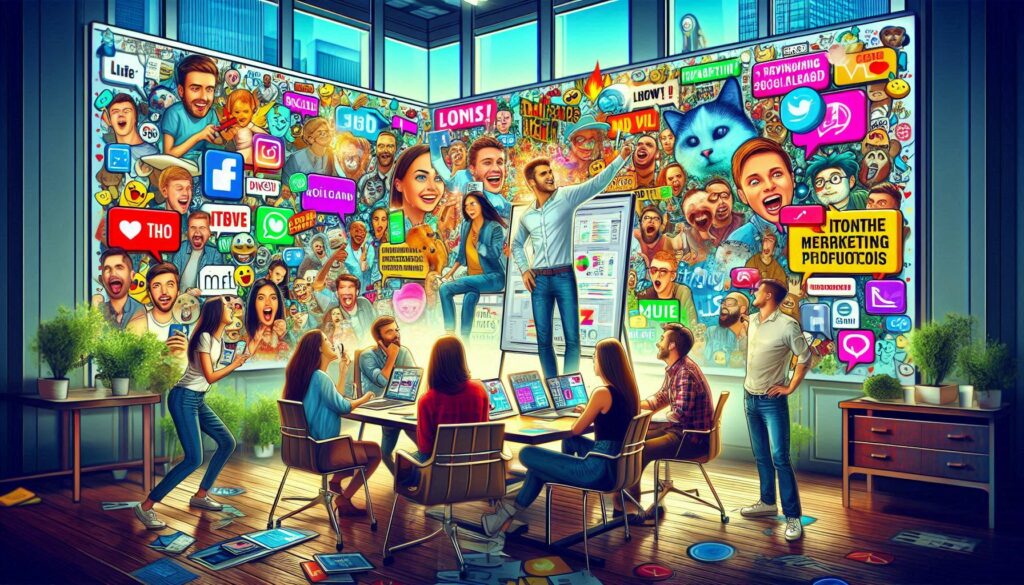Memes have become a staple of online life. These quick, and often hilarious images or videos capture a moment or idea in a way that’s instantly shareable. But when brands get involved, it’s not just about laughs. It’s a clever way to tap into how people think and act. Meme-based marketing uses these cultural snippets to promote products or services, often with minimal budget but maximum reach, especially among younger crowds like Gen Z. Let’s try and unpack why memes work so well psychologically, how they shape what consumers do, and how marketers can use them smartly without stepping on toes.
Psychological Foundations of Memes
At their heart, memes thrive on emotions that hit fast and hard. Humor is the big one. It lowers our guards and makes us feel good, releasing dopamine that keeps us coming back for more. Beyond laughs, things like nostalgia or irony pull us in, creating a sense of connection because they reflect shared experiences. It’s like memes speak a secret language that bonds people, reinforcing group identities where everyone gets the joke.
Then there’s the social side. Memes make us feel part of something bigger, like an inside club. They play on our need to belong, using cultural nods that say, “Hey, we’re on the same wavelength.” Cognitively, their simplicity is key—they’re easy to process in our scroll-heavy world, with visuals and text that grab attention without much effort. That surprise element, like an unexpected twist, triggers curiosity and makes them stick in our minds, much like the Zeigarnik effect where unfinished thoughts linger.
Neurologically, it’s all about rewards. Sharing a meme that resonates feels satisfying, lighting up brain areas linked to pleasure. High-energy emotions like excitement or awe push virality more than calm ones, explaining why memes spread like wildfire.
Memes and Consumer Behavior
When brands weave memes into their posts, it changes how we see them—they come off as relatable, not stuffy corporations. This human touch builds loyalty, turning passive viewers into fans who stick around. But get it wrong, and it can backfire, making the brand seem out of touch.
On buying decisions, memes act as subtle nudges. They’re low-key intros to a brand, sparking awareness that can lead to purchases down the line. Engagement from memes boosts intent, as people interact more when something’s fun. Virality comes from that share factor, letting users express themselves while spreading the word organically.
Gen Z loves this stuff because it’s authentic to their world. They’re quick to spot fakes, so memes that align with their humor win big, differing from older groups who might prefer straightforward ads.
Measuring Emotional Resonance to Meme-Based Marketing
Likes and shares are easy to count, but they miss the deeper emotional pull of memes. To really gauge resonance, look at sentiment in comments—positive vibes indicate connection. Time spent viewing or brand recall surveys reveal if the meme stuck emotionally.
Tools like AI analytics help track these triggers, analyzing reactions for patterns. Focus groups add qualitative depth, showing how memes shift perceptions over time.
Ethical Considerations in Meme-Based Marketing
Memes might seem like harmless fun, but when brands jump in, the stakes get higher. A poorly thought-out meme can spark outrage, legal headaches, or even long-term damage to a company’s reputation. Let’s break this down further, drawing from real-world examples and expert insights to show why ethics matter and how to navigate them.
First off, insensitivity is a major pitfall. Humor in memes often walks a fine line, and what one group finds funny, another might see as offensive. This can lead to swift backlash, especially on social media where things go viral fast. For instance, memes that rely on stereotypes or make light of marginalized communities risk being called out for cultural appropriation or harm. Think about digital blackface—when non-Black marketers use GIFs or images of Black people to express reactions. It echoes historical caricatures and can come across as exploitative, even if unintended. Brands have faced boycotts for this, like when campaigns co-opt trends from specific cultural groups without crediting origins or understanding context. To avoid this, always evaluate how a meme might be perceived by diverse audiences. Ask: Does it punch down? Could it alienate part of my customer base? Internal reviews or test groups can catch issues early.
Aligning with brand values is crucial to dodge the “opportunistic” label. Jumping on a trend just because it’s hot can make a brand look insincere, like it’s chasing clout without genuine connection. This erodes trust—consumers today spot fakes a mile away and aren’t shy about calling them out. For example, if a meme clashes with your company’s ethos, it might confuse or frustrate loyal fans. The key is authenticity: only use memes that fit your voice and message. Develop guidelines for your team, like checking if the humor supports your core principles, to keep things consistent and true.
Copyright is another huge minefield. Most memes are built on someone else’s work—photos, videos, or art that’s protected by law. Repurposing without permission is infringement. Brands have been sued over this. Grumpy Cat’s owners won $710,000 against a company that stretched a licensing deal too far. Even “fair use” isn’t a sure bet for marketing, since it’s commercial and often doesn’t transform the original enough.
The moral side ties in too: memes involve real people, and using their likeness without consent ignores power dynamics and can feel exploitative. Similarly, kids in memes can make it extra tricky, as they can’t consent, and it might affect them later. The best bet is to create your own originals, get permissions, or use licensed stock. Tools like reverse image searches help trace origins.
Over-commercializing is the final big no-no. Turning every meme into a sales pitch can make your brand seem pushy, chipping away at the fun that makes memes engaging in the first place. It erodes trust when audiences feel manipulated. Balance is key. So, mix in genuine, non-salesy content to keep things light. Credit creators publicly, partner with them if possible, and focus on building connections rather than just conversions. This not only avoids backlash but can boost your rep as an ethical player.
In the end, ethical meme-based marketing boils down to respect for cultures, creators, and your audience. Get it right, and memes can humanize your brand. But always prioritize due diligence. It’s cheaper than a lawsuit or lost customers.
Strategic Implementation of Meme-Based Marketing
Crafting memes? Keep them timely, humorous, and relevant—non-salesy tones work best. Pick platforms wisely: TikTok for quick vids, X for witty text. Integrate into bigger campaigns as hooks, or pair with influencers for reach. Test variations with A/B splits and iterate based on feedback.
What the Future Holds for Meme-Based Marketing
Memes are evolving with technology and global audiences, opening new doors for brands. Three key trends include AI-generated memes, AR interactivity, and global cultural adaptability.
AI-Generated Memes: Instant Relevance
AI is revolutionizing meme creation by generating real-time, trend-aligned content. Tools like Simplified analyze social media to produce memes that match current buzz, like a brand riffing on a viral X post in hours. AI can personalize memes for specific audiences, boosting engagement. But overly polished AI memes risk feeling inauthentic, and heavy data use raises privacy concerns. Brands should blend AI with human creativity and transparent data practices to stay ethical.
Interactive AR Memes: Deeper Engagement
Augmented reality (AR) turns memes into immersive experiences. AR campaigns can lift engagement, tap into curiosity and reward psychology. But they are costly and risk overcomplication. Ethically, avoid intrusive data collection. Keep AR memes simple and fun for impact.
Global Cultural Adaptability
Memes must resonate across cultures as brands go global. A U.S.-centric meme might flop in Asia without local tweaks, like Netflix using K-drama clips for Korean fans. AI can suggest localized formats, but human oversight prevents cultural missteps. Misjudge humor, and you risk backlash. Hire local experts to ensure authenticity and build trust in new markets.
Memes pack a psychological punch, driving behavior through emotion and connection. For marketers, they’re a tool for real engagement, if done ethically. Start small, test, and keep it genuine to turn laughs into lasting loyalty.


